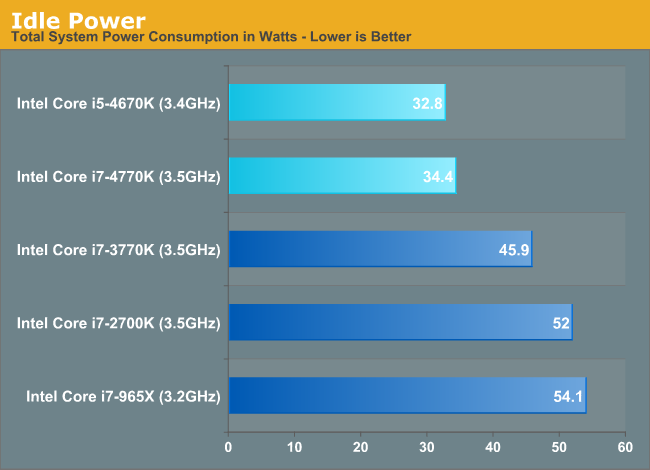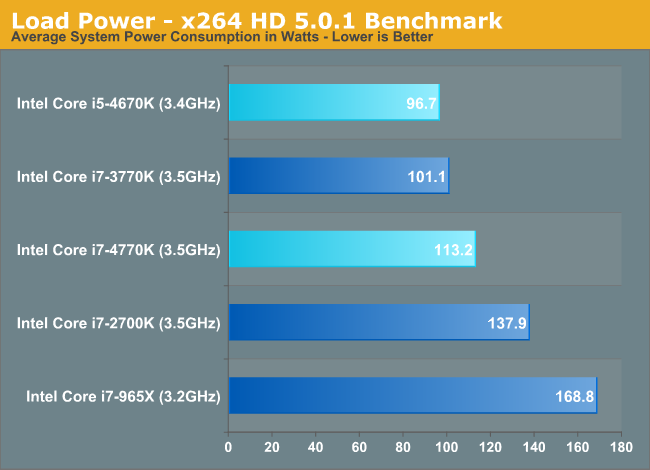The Haswell Review: Intel Core i7-4770K & i5-4670K Tested
by Anand Lal Shimpi on June 1, 2013 10:00 AM ESTPower Improvements
Although Haswell’s platform power is expected to drop considerably in mobile, particularly with Haswell U and Y SKUs (Ultrabooks and ultrathins/tablets), there are benefits to desktop Haswell parts as well.
There’s more fine grained power gating, lower chipset power and the CPU cores can transition between power states about 25% quicker than in Ivy Bridge - allowing the power control unit to be more aggressive in selecting lower power modes. We’ve also seen considerable improvements on lowering platform power consumption at the motherboard level as well. Using ASUS’ Z77 Deluxe and Z87 Deluxe motherboards for the Haswell, Ivy and Sandy Bridge CPUs, I measured significant improvements in idle power consumption:

These savings are beyond what I’d expect from Haswell alone. Intel isn’t the only one looking to make things as best as can be in the absence of any low hanging fruit. The motherboard makers are aggressively polishing their designs in order to grow their marketshare in a very difficult environment.
Under load, there’s no escaping the fact that Haswell can burn more power in pursuit of higher performance:

Here I’m showing an 11.8% increase in power consumption, and in this particular test the Core i7-4770K is 13% faster than the i7-3770K. Power consumption goes up, but so does performance per watt.
The other big part of the Haswell power story is what Intel is calling FIVR: Haswell’s Fully Integrated Voltage Regulator. Through a combination of on-die and on-package circuitry (mostly inductors on-package), Haswell assumes responsibility of distributing voltages to individual blocks and controllers (e.g. PCIe controller, memory controller, processor graphics, etc...). With FIVR, it’s easy to implement tons of voltage rails - which is why Intel doubled the number of internal voltage rails. With more independent voltage rails, there’s more fine grained control over the power delivered to various blocks of Haswell.
Thanks to a relatively high input voltage (on the order of 1.8V), it’s possible to generate quite a bit of current on-package and efficiently distribute power to all areas of the chip. Voltage ramps are 5 - 10x quicker with FIVR than with a traditional on-board voltage regulator implementation.
In order to ensure broad compatibility with memory types, there’s a second input voltage for DRAM as well.
FIVR also comes with a reduction in board area and component cost. I don’t suppose this is going to be a huge deal for desktops (admittedly the space and cost savings are basically non-existent), but it’ll mean a lot for mobile.
No S0ix for Desktop
You’ll notice that I didn’t mention any of the aggressive platform power optimizations in my sections on Haswell power management, that’s because they pretty much don’t apply here. The new active idle (S0ix) states are not supported by any of the desktop SKUs. It’s only the forthcoming Y and U series parts that support S0ix.










210 Comments
View All Comments
winterspan - Monday, June 3, 2013 - link
So, can someone catch me up with why Haswell isn't being compared to the older Core i7-39xx Sandy Bridge chips with 6 cores (Sandy Bridge E series)? Is it because they are based on the Xeon architecture and thus are not directly comparable? Will we see an Haswell-E (or Ivy Bridge E) series-based Core i7 with more than 4 cores as a follow-up to the Core i7-39xx?TomWomack - Monday, June 3, 2013 - link
Yes, Ivy Bridge E should appear in the fall; it's not at present quite clear how many cores it will have, possibly only six with the 8- and 12-core units reserved for sale as Xeons.Asking anandtech.com/bench to compare a 4770K and a 3930X, Haswell wins on single-thread and loses on some multi-thread tests, which is what you'd expect.
Kevin G - Monday, June 3, 2013 - link
Probably because it'd be embarrassed in some cases. For lightly threaded workloads, the i7 4770k would come out on top. The six core i7 39xx chips need heavily threaded applications to really shine. Also of note is that GT3e versions of Haswell have 128 MB of L4 cache which further improves IPC. A hypothetical 3.5 Ghz fully functional Haswell with GT3e and recompiled software will likely out run an 8 core socket 2011 Xeon.boe - Monday, June 3, 2013 - link
Pretty much a big steaming pile of meh.They should have at least put more PCIe lanes on the thing otherwise it is just last years processor by another name.
milkod2001 - Monday, June 3, 2013 - link
What revision of i7-4770K was tested here? There's been rumors about early Haswell revisions giving some problems to usb3 connected devices. When in sleep mode it can't wake up after that:http://www.tomshardware.com/news/Haswell-USB-3.0-S...
Would love to see some additional tests covering this problems to make sure I won't spend weeks sending faulty CPU back, waiting and all that s..t.
Diogenes5 - Monday, June 3, 2013 - link
TIL that my 2-year-old i2500k still rocks it for the price and the overclock I have it at (beats any current gen processor for most tasks).Oscarcharliezulu - Monday, June 3, 2013 - link
Thx for the review Anand, as always very thoughtful and well written. You always have a good mix of objective and intelligent subjective. Looking forward to Ivy-E now.psuedonymous - Monday, June 3, 2013 - link
Dangit Anand! Why are you still using 2-pass encoding? Everyone and their dog have switched to the faster and more effective CRF. It may have some obscure use as a synthetic benchmark, but it's certainly not a real world one!skrewler2 - Monday, June 3, 2013 - link
Pretty annoying they're still not including VT-d support in their K series.SanX - Monday, June 3, 2013 - link
Anand gets on my nerves lately. Smells like shill articles everything he personally covers.